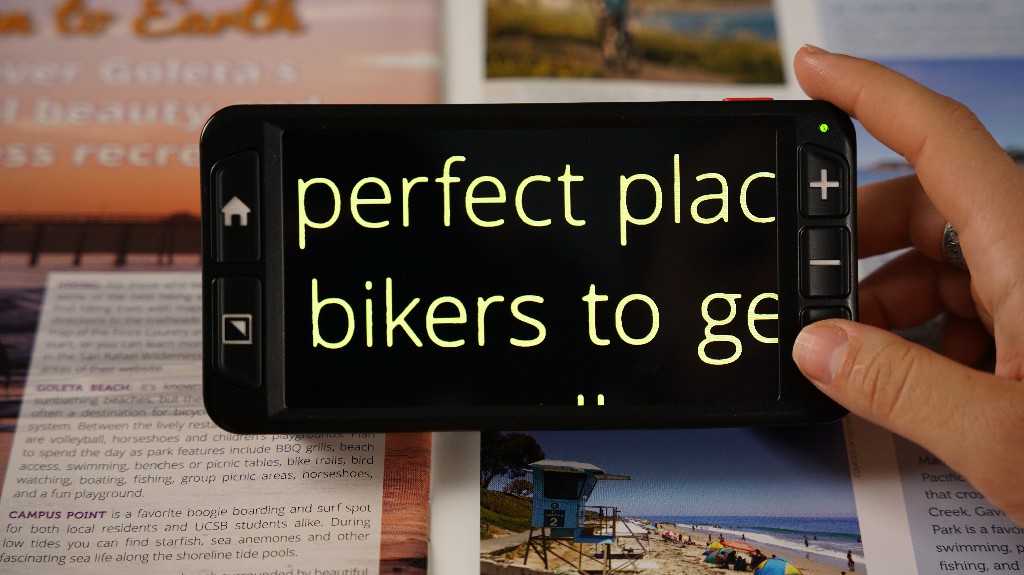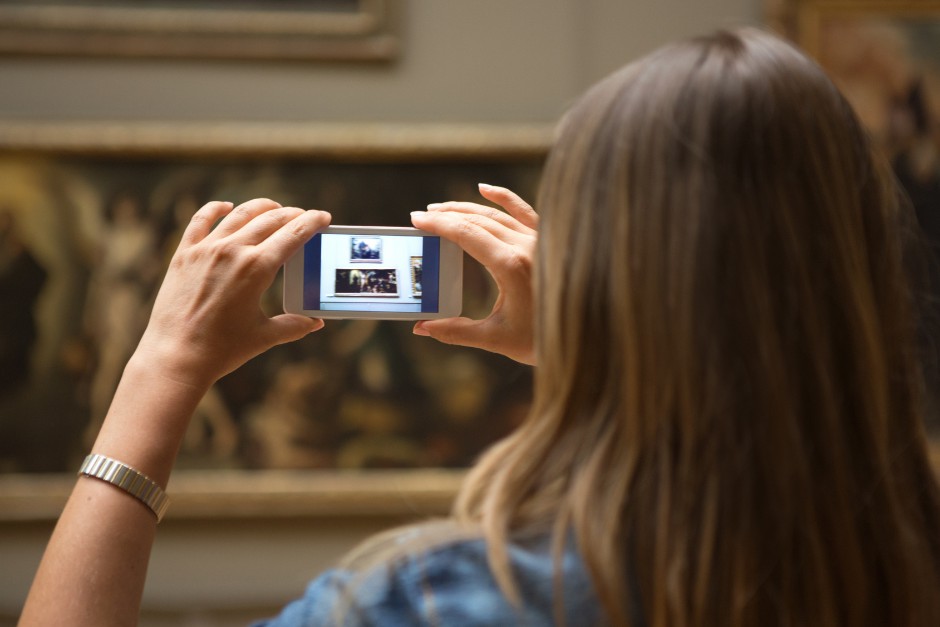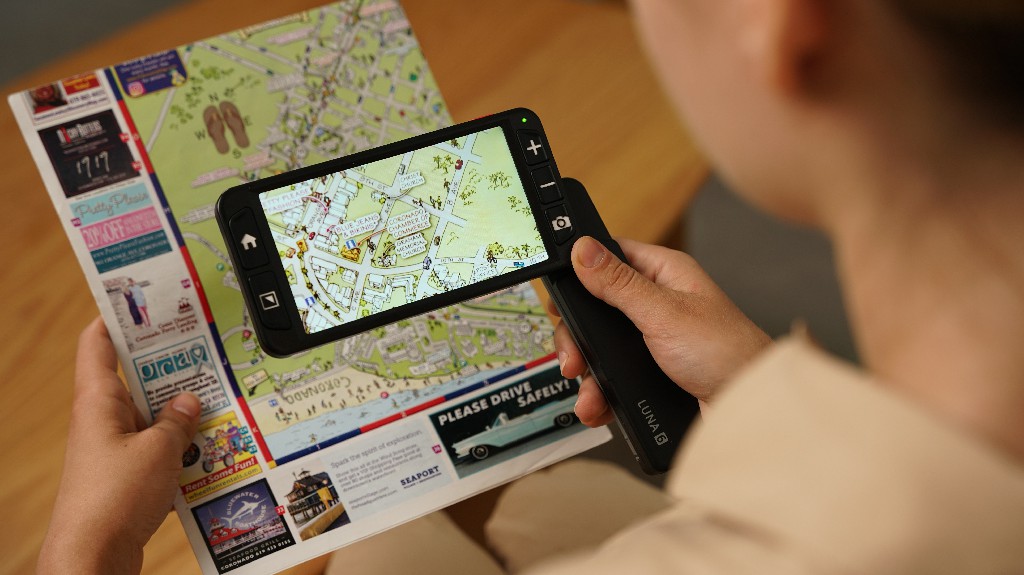Museums usually carry abundant human culture, history or art of a certain city or period. They not only preserve valuable heritage but also inspire future innovation. Museums serve as reservoirs of knowledge and educational spaces, using exhibits and technology to offer wonderful visual and intellectual experiences for visitors. Before back-to-school for the new semester, now it’s the perfect time for students to visit the museums for discovering more knowledge.
Students with low vision should not miss this kind of opportunity as well. if worrying about the vision barrier would affect reading the instructions of exhibits, then just taking a handheld video magnifier, visually impaired students are able to enjoy museums individually.
About Handheld Video Magnifiers
Handheld video magnifiers, commonly referred to as electronic or digital magnifiers, are small, lightweight aids for those with limited vision or other visual impairments. These tools use a high-resolution camera and display to instantly enlarge printed text, photos, or objects, giving users better vision and the ability to read. To satisfy various visual requirements, handheld video magnifiers frequently provide a series of useful functions like a wide range of magnification levels and multiple contrast options. By enabling more comfortable reading of books, newspapers, menus, and other written items, these tools help people be more independent and accessible in their daily lives.
 Handheld video magnifiers are the best choice to help visually impaired people due to all these features. To talk about a specific example, Zoomax Luna 6, is able to help people who have visual impairments enjoy their extraordinary museum tour. The 6 inches screen of Luna 6 can offer sharp and high quality images, and demonstrate content as much as possible to access more information. Meanwhile, the digital device possesses reading lines and mask functions to help visually impaired people locate the target accurately while they’re standing. This handheld video magnifier perfectly meets the needs of visiting a museum for people with low vision.
Handheld video magnifiers are the best choice to help visually impaired people due to all these features. To talk about a specific example, Zoomax Luna 6, is able to help people who have visual impairments enjoy their extraordinary museum tour. The 6 inches screen of Luna 6 can offer sharp and high quality images, and demonstrate content as much as possible to access more information. Meanwhile, the digital device possesses reading lines and mask functions to help visually impaired people locate the target accurately while they’re standing. This handheld video magnifier perfectly meets the needs of visiting a museum for people with low vision.
In fact, for visually impaired people who would like to try digital magnifiers for the first time, the handheld ones are also the ideal selection among various types of low vision aids. The handheld electronic magnifier stands out for its convenience and ease-to-use. This type of device is distinguished by its small size and user-friendly interface, making it simple for anyone to incorporate into daily tasks without special training or technical knowledge.
In addition, the affordability of handheld electronic magnifiers is another compelling factor. The handheld video magnifiers are generally less expensive than more complex assistive gadgets, which lessens the initial financial strain involved with adopting such equipment. Also, the portability of handheld video magnifiers allows people with low vision to use them in a variety of scenarios, including at home, outside, while traveling, or in a museum’s immersive environment. In this case, these handheld video magnifiers actually achieve more functionality than daily uses.
Most importantly, the handheld electronic magnifiers give substantial and apparent enhancements to the reading and observing experiences of people with vision loss. These immediate, noticeable advancements help to increase the user’s trust in the technology and generate their curiosity to learn more and potentially explore additional innovative capabilities and gadgets. For people with low vision, the handheld electronic magnifier is the best way to get started using electronic visual aids. These tools encourage an active interest in exploration and progressive adaption to this unique technical tool by providing practicality, ease, and a gateway to improved eyesight.
How Handheld Video Magnifiers Work in the Museums
When discussing the practical applications of handheld electronic magnifiers in museums, here are some specific aspects to explain their superiority:
 Viewing Exhibit Information: The high-resolution camera of handheld electronic magnifiers captures delicate exhibit details, magnifying them for display. This allows individuals with low vision to delve deep into observing exhibits, appreciating even small differences, from sculptural textures to the complexity of historical relics, all in a comprehensive field of view.
Viewing Exhibit Information: The high-resolution camera of handheld electronic magnifiers captures delicate exhibit details, magnifying them for display. This allows individuals with low vision to delve deep into observing exhibits, appreciating even small differences, from sculptural textures to the complexity of historical relics, all in a comprehensive field of view.
Reading Exhibit Labels: To read the labels of the exhibit is necessary for visitors in order to get to know more about the exhibits, usually including amazing cultures or heavy history, which leads to the meaning of visiting the museums. With handheld video magnifiers, people with eyesight loss can easily understand the history, culture, and artistic background of each exhibit.
Navigation Assistance: The ability to navigate is essential for visitors, ensuring they don’t miss any of the exhibits as the museums are usually expansive and consist of various exhibition halls. Handheld digital magnifiers allow people with low vision to read and interpret directional signs, maps, and floor plans, enabling them to plan their routes effectively. In doing so, they won’t miss the exhibit they’re really interested in.
 Reading Printed Materials: Apart from exhibit labels, museums often contain a wealth of printed materials, such as exhibition brochures and guidebooks. The magnification feature of handheld electronic magnifiers enables low vision people to independently read these materials, gaining more information about the exhibits. Meanwhile, adjusting magnification is just one aspect, the handheld electronic magnifiers can also change color contrast and activate the reading line and mask function, which helps people with impaired vision read brochures more easily.
Reading Printed Materials: Apart from exhibit labels, museums often contain a wealth of printed materials, such as exhibition brochures and guidebooks. The magnification feature of handheld electronic magnifiers enables low vision people to independently read these materials, gaining more information about the exhibits. Meanwhile, adjusting magnification is just one aspect, the handheld electronic magnifiers can also change color contrast and activate the reading line and mask function, which helps people with impaired vision read brochures more easily.
Recording Memories: Some people may forget about this key function of digital visual aids. Commonly, digital magnifiers are equipped with image capture functionality, like Zoomax Luna 6, which allows users to capture photos of exhibits of interest, creating personalized memories of their museum visit. They can share these saved images with friends or families, to increase their social interactions as well.
Gaining Deeper Historical Insights: By using digital magnifiers to check details and read relevant information about the exhibits, low vision people gain a deeper understanding of the historical stories behind the exhibits, enriching their overall comprehension. It’s beneficial to the visually impaired people in a mental way, to enrich their mental world and bring more cultural knowledge.
Sharing the Experience: During the visit, the handheld electronic magnifiers can be a way for people with vision loss to share their experiences with other visitors. They can use the device to observe exhibits and engage in discussions, promoting communication and interaction to collectively explore exhibit content and value. It’s also another way to promote the social relationships of visually impaired people.
 Increasing Independence and Boosting Confidence: Increasing Independence and Boosting Confidence: Beyond enriching the museum experience, a key point of using handheld electronic magnifiers in museums is to foster independence and boost the confidence of individuals with the visually impaired. The ability to independently read exhibit information, explore details, and move around the museum more effortlessly grants them unprecedented autonomy. This independence positively impacts their self-esteem and overall well-being.
Increasing Independence and Boosting Confidence: Increasing Independence and Boosting Confidence: Beyond enriching the museum experience, a key point of using handheld electronic magnifiers in museums is to foster independence and boost the confidence of individuals with the visually impaired. The ability to independently read exhibit information, explore details, and move around the museum more effortlessly grants them unprecedented autonomy. This independence positively impacts their self-esteem and overall well-being.
In conclusion, the application of handheld electronic magnifiers in museums not only provides individuals with low vision a more enriched experience but also elevates their independence and self-confidence. By promoting autonomy and confidence, these devices enable people with visual impairments to enjoy a fulfilling museum journey, broadening their horizons, and enhancing their quality of life.
Of course, besides Zoomax Luna 6, there are various selections of low vision products to enrich the experiences of visiting museums for visually impaired people. The portability of low vision aids shall be the priority to consider if you want to try starting an independent tour to learn or experience cultures or history in a museum. With suitable digital magnifiers, people with low vision are able to access exhibit information, read materials, and navigate the museum environment more effectively to actively participate in the museum tour and get a more comprehensive visual experience.
On the other hand, it’s not recommended for students who have vision loss and don’t train for outdoor walking or visually impaired children who are still at a young age to visit the museums lonely even with a proper handheld video magnifier. There might be dim lights and many stairways in the museum, but an adult with good vision can always provide more help for those with low vision.

